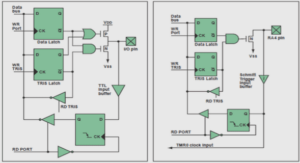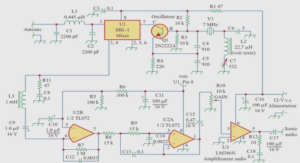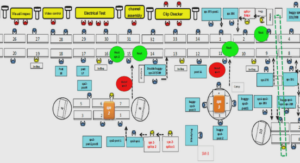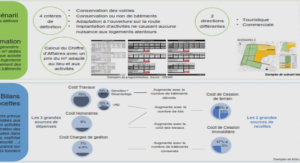Procédure expérimentale pour caractériser les boues pâteuses à hautes températures
Lors du séchage dans un sécheur par contact avec agitation (type sécheur à palettes ou sécheur à disques), la température de la boue est comprise entre 90 et 120°C [36]. Pour travailler dans des conditions de température similaires lors des mesures rhéologiques et ainsi évaluer l’impact de la température sur les propriétés rhéologiques, les boues peuvent être chauffées dans le rhéomètre. Cependant, l’évaporation peut fortement biaiser les résultats expérimentaux. Les techniques traditionnelles recommandées dans la littérature pour contrôler l’évaporation ne se sont pas révélées très efficaces à haute température. Par conséquent, développer une procédure pour contrôler/limiter l’évaporation s’est avéré indispensable. δa procédure élaborée vise à contrôler l’évaporation à haute température en utilisant une configuration accessible à tout rhéomètre commercial. Le principe consiste à empêcher l’évaporation du solvant (l’eau dans le cas présent) en limitant le contact entre la boue cisaillée et l’environnement.
Description de la procédure pour contrôler l’évaporation de l’eau lors des mesures rhéologiques à haute température-Article 2
Ce travail a fait l’objet d’une communication orale au congrès SMICE 2018 (Rome, Mai 2018), puis a été sélectionné pour publication dans Water Science and Technology. Le document proposé ci-après est publié dans cette revue. Mouzaoui, M., Baudez, J.C., Sauceau, M., Arlabosse, P. How to avoid evaporation during rheological measurements of dewatered pasty sludge at high temperature. Water Science and technology, 2019, Vol. 79, Issue 8, p. 1503-1510. DOI : https://doi.org/10.2166/wst.2019.150 Afin d’éviter le problème de la solubilisation de la matière organique à hautes températures, les boues utilisées dans cette partie sont préalablement traitées thermiquement.
Sludge
Pasty sludge was sampled at the waste water treatment plant from Albi city (France) at the outlet of the centrifuge. Its initial TS (standard EN 12880:2000) was 20 wt.% and the volatile solid (VS, standard EN 12879:2000) content was about 63 wt.% (of dry weight). Samples with higher TS contents have been prepared in a filtration/compression cell inserted in a hydraulic press (Carver USA). A sludge mass of 0.8 kg is pressed for 48 and 72 h at a pressure of 30 bar. The temperature of the laboratory is maintained at 20 °C. Several authors have shown that the solubilisation of organic matter (from the solid phase to the liquid phase) at high temperature irreversibly modifies the structure of the sludge and therefore its rheology [1–4]. The time and the temperature of thermal treatment are the dominant factor influencing the organic solubilisation and thus the rheological parameters. Indeed, the organic matter solubilisation during thermal treatment, could reach a stable state within 30-60 minutes with respect to temperatures higher than 100°C [5,6] but ranged from hours to days at temperatures lower than 100°C [6–8]. Xue et al [8] and Zhang et al. [6] investigated the effects of thermal treatment on organic matter solubilisation on pasty sludge (TS around 17 %). They showed that the solubilisation of the organic matter increases as function of time but tends toward a stable state at around 24 hours of thermal treatment at temperature between 60 and 90°C. Thus, to avoid the problem of solubilization during rheological tests at high temperatures, the samples are pretreated thermally at 90°C for at least 24 hours before the measurements. The TS and VS contents have been determined before and after the thermal treatment to check that this treatment did not alter the sludge. The table 1 shows the result for the initial sludge.
Rheological measurements
Rheological measurements are performed with a stress-controlled rheometer (HAAKE RheoStress 600, Thermo Scientific, Germany). The upper part supplies measurements, while the lower part is fixed. Two configurations described thereafter are implemented. A constant dynamic strain (γ=0.3 %) in the linear viscoelastic range (LVE) is applied. Viscous modulus G”, elastic modulus G’ and loss tangent Tan Ɂ (viscous to elastic modulus ratio) are tracked during enough time with 1 measurement every 10 seconds. This will help at evaluating the evaporation kinetics of sludge, and hence, at defining the appropriate conditions to prevent evaporation.
Plate-plate configuration
The geometry consists of a classic serrated plate-plate with a 35 mm diameter (Fig. 1). The gap is kept constant at 2 mm. A peltier temperature controller is connected to the lower plate. To prevent evaporation, measurements were carried out in a vapour saturated medium by using a cover and a vapour trap (Fig. 1). The vapour trap is connected to the shaft of the upper plate. Its principal role is to provide a tight seal between the shaft and the cover. A ring is mounted directly onto the cover: when the cover is placed, the ring lowers into the solvent in the vapour trap. The water on the lower plate is acting as liquid to saturate air trapped in the chamber (under the cover). It can contain up to 2 ml of water which is sufficient to saturate the air even at 80 °C. For example, based on humid air material balance calculi, the quantity of water needed to saturate the chamber at 80 °C is close to 0.5 ml. As a result, the chamber will be maintained saturated. Thereafter, only experiments without the vapour trap will be notified (no protection).
Plate-cylinder configuration
The geometry consists of a serrated upper plate (35 mm diameter) coupled with a lower cylinder (36.88 mm inner diameter and 50 mm depth; see Fig. 2). A temperature-regulated bath is connected to the lower cylinder. The sludge sample (at a constant volume each experiment) is introduced into the measuring cylinder (Fig. 2-a). Then the upper plate is placed so as to form a sludge ring around the upper plate of height h=1.5 mm (Fig. 2-b). This step aims at limiting the contact between the sheared sludge and the environment. The upper plate is turned around ϕ=2 rad (Fig. 2-b) to eliminate residual stresses generated by the ring of sludge. Because of the latter step, the sample may not adhere correctly to the lower surface of the upper plate. To ensure this contact, the upper plate is lowered again of 0.5 mm: the new height of the sludge ring is thus h+0.5 mm (Fig. 2-c)






